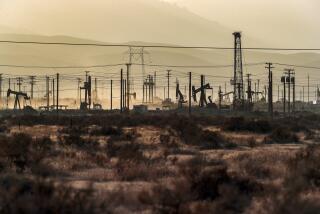A Lot of Hot Air Could Save Utilities a Bundle
- Share via
Power plants that use hot, compressed air to turn underground caves into energy storage tanks could solve a major problem for electric utility companies and save as much as $50 billion in future construction costs, according to industry researchers.
The first storage facility in the United States to use compressed-air technology will be dedicated in Alabama on Friday. That’s good news, but better yet, say energy researchers and environmentalists, is that such systems could be applicable in 75% of the country--including California.
“Three-fourths of the United States has geology suitable for underground air storage,” Robert Schainker, energy storage program manager for the Electric Power Research Institute, said in a written statement. The institute, based in Palo Alto, Calif., manages most of the U.S. utility industry’s research and development.
“If they really think the siting potential is that widespread, that’s good news,” said Warren Liebold, a member of the Sierra Club’s national energy committee. “It’s relatively benign, environmentally. And if the plant is going to operate and feed electricity into the (system), it’s not just a lot of hot air.”
In California, the Sacramento Metropolitan Utility District tested for--but failed to find--geologically suitable land to use for compressed-air storage in 1988. Pacific Gas & Electric Co. is studying a possible site for a demonstration facility in a former natural-gas field in California’s Central Valley.
Other major California utilities are aware of the technology, which uses almost entirely proven, off-the-shelf systems, but none have yet built such a facility.
To meet future electricity demands, public regulators across the country are pressing utility companies to concentrate on alternative ways to produce energy. But one big hitch has been finding a way to store energy that is produced in cheaper, off-peak hours, for use during times of greatest demand.
The compressed-air storage method could allow utilities to avoid building as much as $50 billion worth of new power plants, according to utility industry researchers, by deferring the need for as much as 50,000 megawatts of new generating capacity.
The new Alabama plant will compress air using electricity generated at night, which costs less than that generated during daytime demand hours. The air will then be stored in a cavern 1,500 feet below the ground, in a vault 220 feet in diameter and 1,000 feet high, formed from a salt dome. When power demand increases, the air will be released, heated and used to drive turbines to make new electricity.
Located 40 miles north of Mobile, the new plant is owned by the Alabama Electric Cooperative, a $65-million facility that generates electricity for 250,000 residents of Alabama and Florida.
The storage method has been used successfully since 1978 in a commercial power plant in Germany.
Environmentalists are enthusiastic about the plant, because it uses ordinary air, not an exotic or potentially hazardous substance, for storing the energy. Utilities see long-term potential in the technique’s ability to increase use of thermal, solar, wind and photovoltaic electricity. Compressed-air storage would allow this power to be used when needed, not just when it is generated.
“Eventually it will help out the cleanest and most renewable energy systems, which are intermittent resources,” said James R. Birk, director of EPRI’S storage and renewable energy efforts.
How Air Power Works The Alabama Electric Cooperative plant, the first to use compressed air energy storage, will pump ordinary air into a 19-million-cubic-foot cavern--using electricity generated relatively cheaply during off-peak hours to run the pumps. The compressed air itself retains the energy produced. When more electricity is needed, air is released, heated with natural gas or oil and used to propel an electricity-generating turbine. The cavern will store at any time enough energy to supply the electricity demands of 11,000 homes.
More to Read
Inside the business of entertainment
The Wide Shot brings you news, analysis and insights on everything from streaming wars to production — and what it all means for the future.
You may occasionally receive promotional content from the Los Angeles Times.










